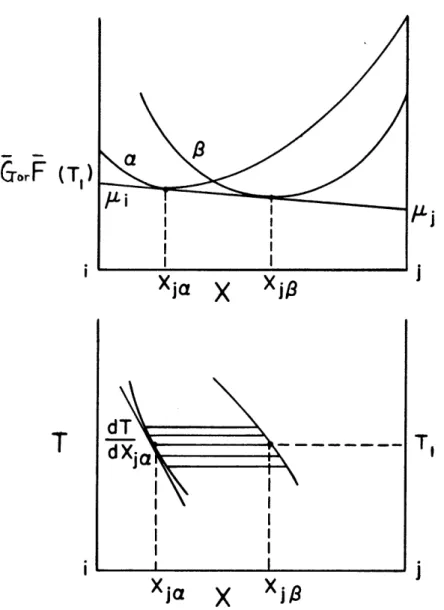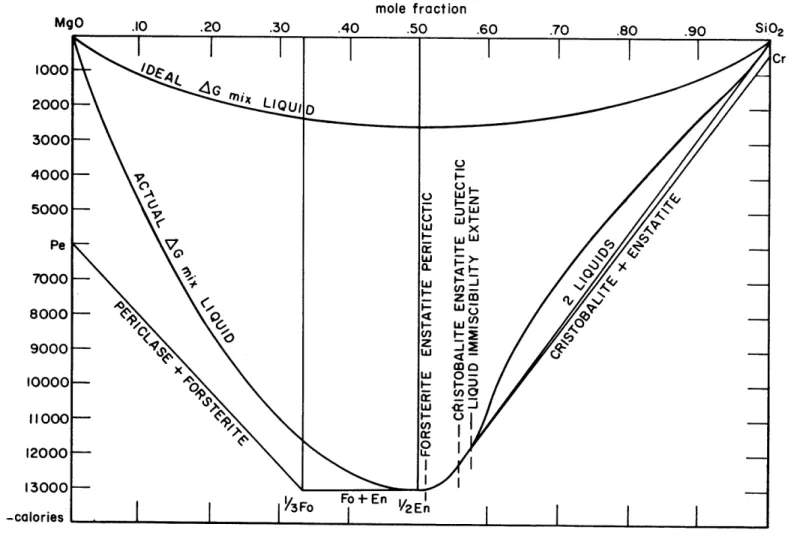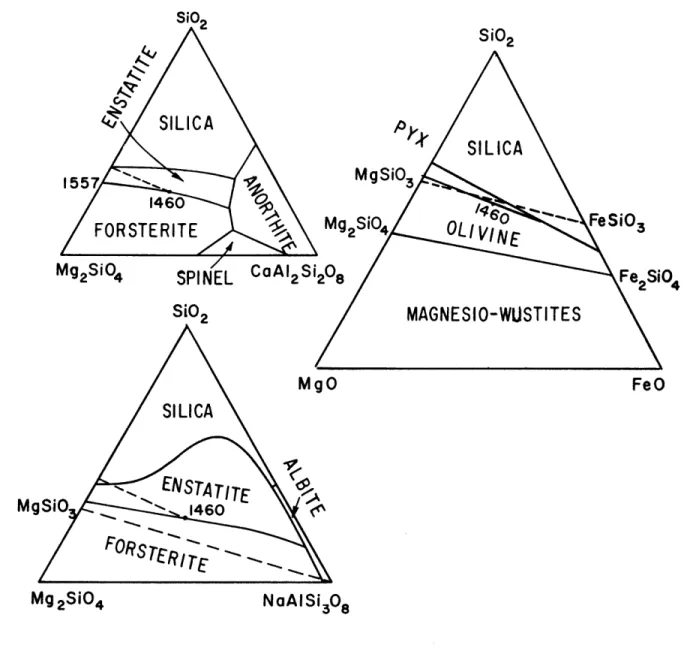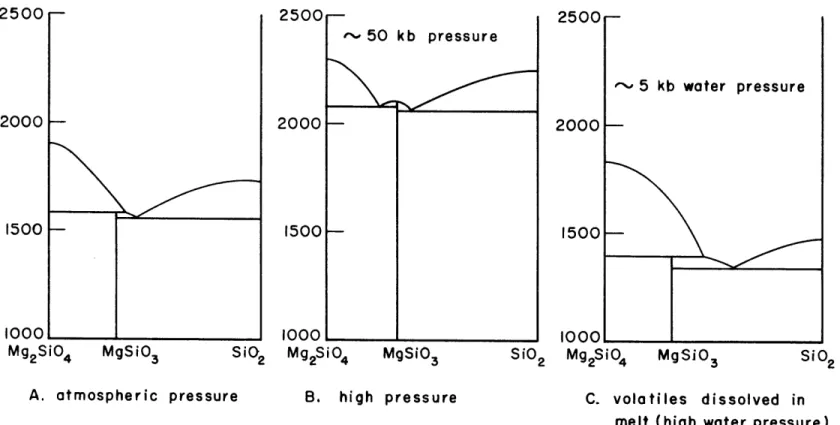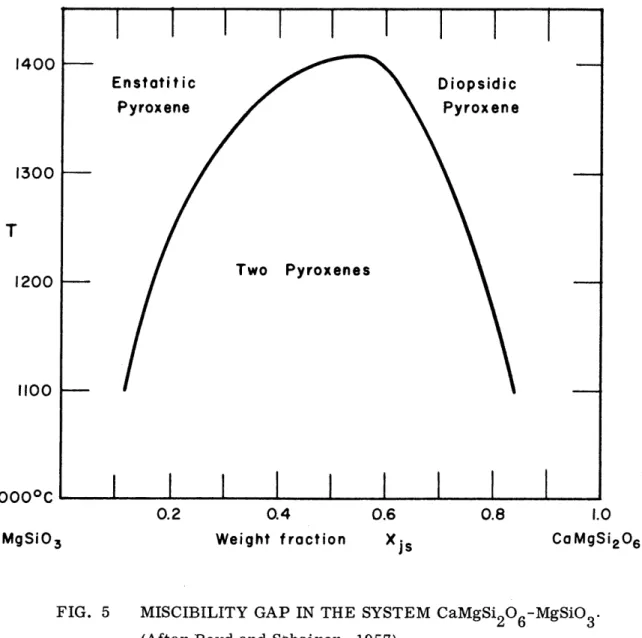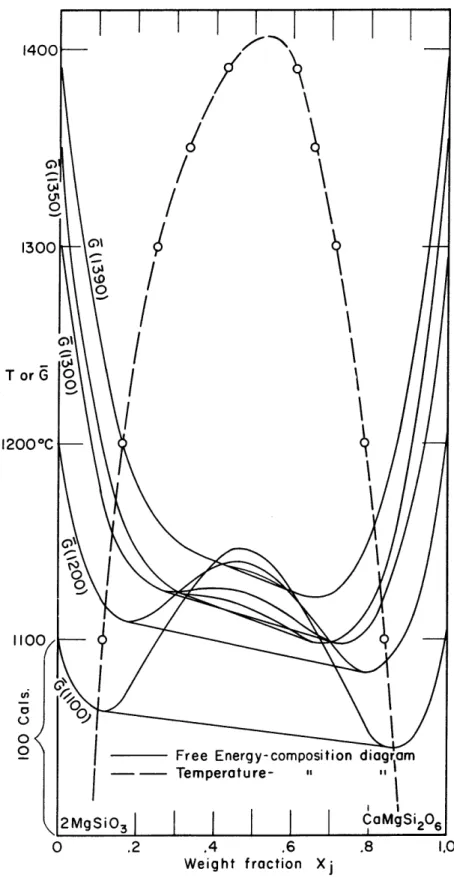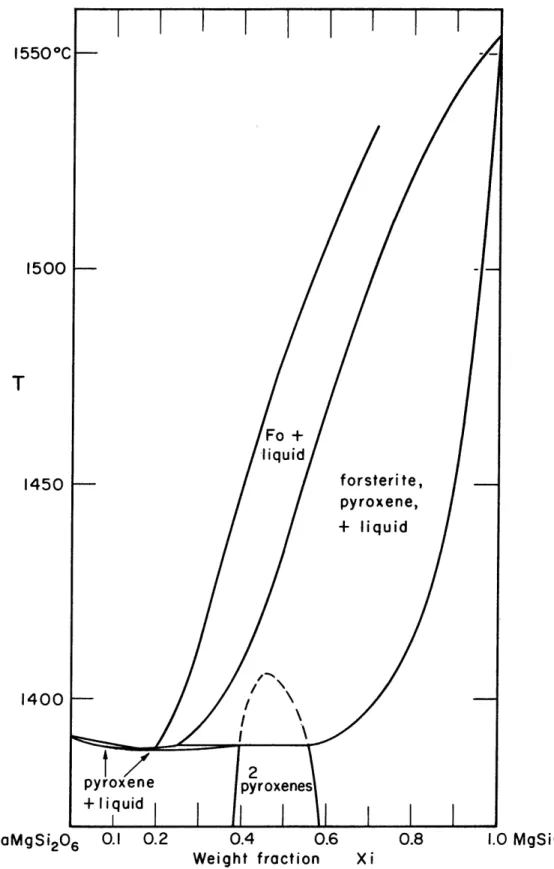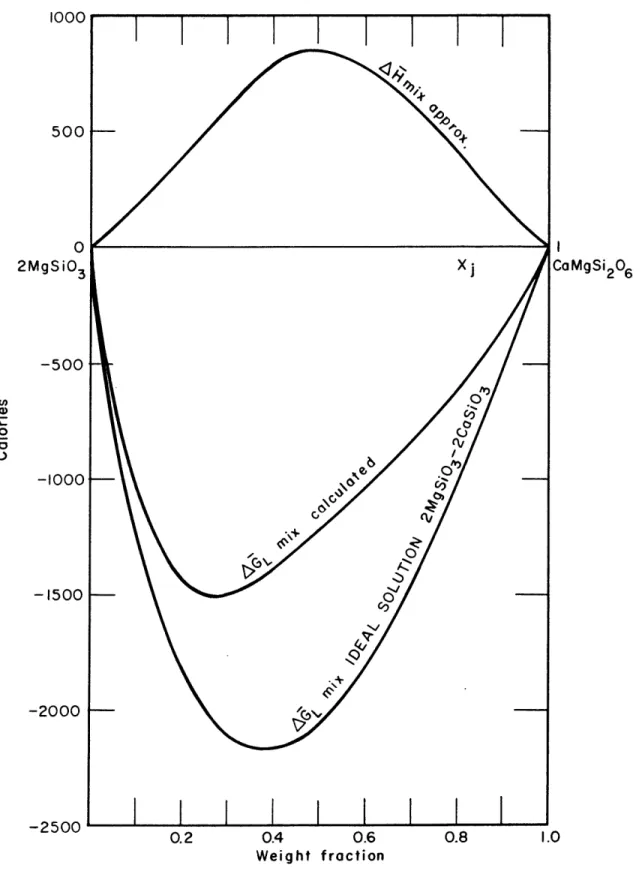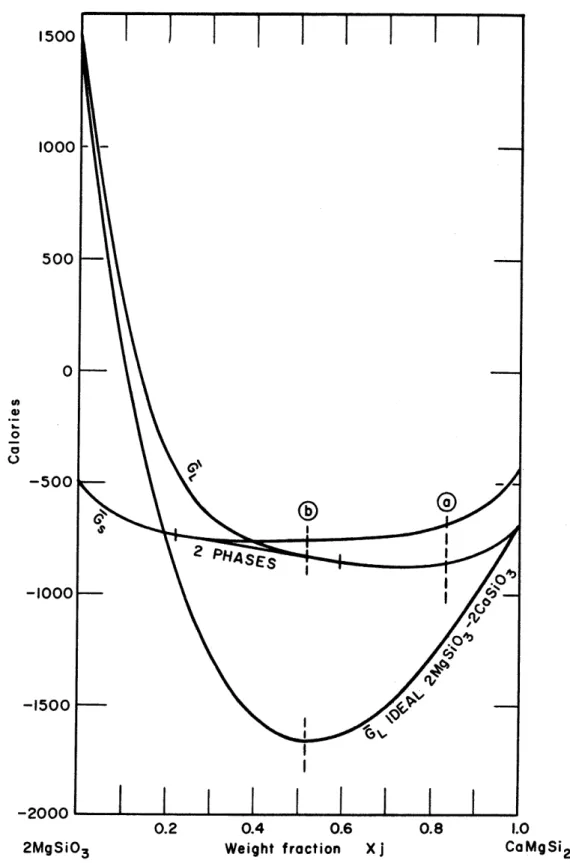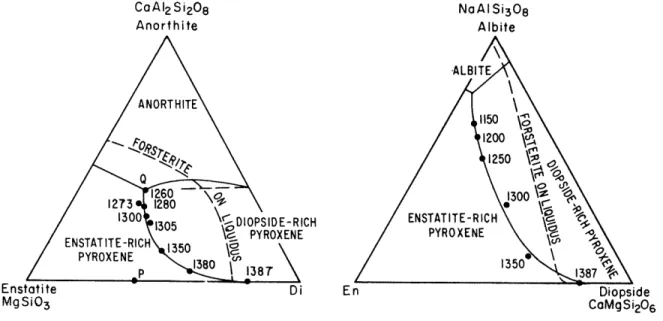V
DIFFERENTIATION CONTROLS IN SUBSILICEOUS
GABBROS by
GEORGE HALSEY BEALL B.Sc., McGill University
(1956)
M.Sc., McGill University (1958)
SUBMITTED IN PARTIAL FULFILLMENT OF THE REQUIREMENTS FOR THE
DEGREE OF DOCTOR OF PHILOSOPHY at the MASSACHUSETTS INSTITUTE OF TECHNOLOGY August, 1962 Signature of Author ... ,.. ... . . Department of Geology and Geophysics, August 20, 1962 Certified by ...
Accepted by ...
,. * .* .* Thesis Supervisor
Chairman, Departmental Committee on Graduate Students
DIFFERENTIATION CONTROLS IN SUBSILIOEOUS GABBROS
by George
H.
Beall
Submitted to the Department of Geology and Geophysics
on August 20, 1962, in partial fulfillment of the
require-ments for the degree of Doctor of Philosophy.
Abetract.
Subsiliceous gabbros fall into two classes, a magnesian
group, the olivine tholeiites, composed largely of normative
components olivine, hypersthene, diopside, and plagioclase,
and
a more calcic group, the basanites, composed largely of
normative components diopside, olivine, anorthite, and some
nepheline.
The position of the olivine-orthopyroxene liquidus
boundary exerts a dominant influence on the course of
differen-tiation of the olivine tholeittes.
Increasing pressure shifts
this boundary away from silica; the effect of dissolved
volatiles is to shift it towards silica, Fractional
crystal-lization taking place in a 'wet' environment will therefore
result in the precipitation of more olivine than would occur in
a 'dry' environment. Consequently, the residual magmas of
deep
crystallization are likely to be more enriched in silica than
those which form close to the surface.
While experiments have shown that the addition of
plagioclase to the system diopside-enstatite shifts the
pyroxene liquidus minimum from about Di 80 En 20 to about Di
65
En
35,
field evidence dictates a frequent shift to over 50
per-cent enstatite. Such a shift is expected on theoretical
grounds if abundant steam
is
dissolved in the melt.
The Chukotat Sills of Ungava, Quebec, differentiated
olivine tholeiites, were intruded at considerable depth and
under conditions of considerable volatile content in the melt.
The largest sills are of the settled differentiated type,
char-acterized by an ultrabasic base and a gabbro cap. Field,
microscopic, and chemical evidence all suggest that they were
injected as a mixture of gabbroic magma and olivine crystals.
The latter sank forming a homogeneous layer, and the overlying
gabbro then differentiated. The major effects predicted for
basaltic crystallization under high water pressure are in
evidence, namely, excess olivine accumulation and the
hypersthene shift in the pyroxene liquidus trough.
Aluminum substitution in clinopyroxenes is,
along with
quantity of dissolved volatiles, a critical factor in
deter-mining the course of differentiation of the calcic subsiliceous,
-3-or basanite, magmas. From a zone of residual uncertainty, falling close to the normative composition clinopyroxene-olivine-plagioclase, magmas may differentiate towards criti-cally undersaturated residua or towards saturated and over-saturated residua. Plagioclase saturation at the time of
pyroxene separation plus 'wet' conditions favour more siliceous residua, high aluminum substitution in early pyroxenes, and the
development of silica-poor hydrous phases.
The Monteregian Hills of the Montreal area are basanite stocks of the high temperature and 'dry' type. Differentiation towards critically undersaturated residua was generally
favoured. The sodic nature of these residua, dominantly
nepheline syenites, is due to the initial separation of highly anorthitic plagioclase from the parent magma; the albite compo-nent was severely restricted by the subsiliceous nature of this melt.
The parent magmas of the Chukotat Sills and Monteregian Hills intrusives, representing the two classes of subsiliceous basalts, are believed related in depth of origin. Simple or repetitive partial fusion of a mantle of peridotite composition at depths over 100 kilometers would yield silica-poor melts, largely due to expansion of the pyroxene and garnet liquidus fields with increasing pressure. The magnesium to calcium ratio in the melt would depend directly upon the degree of fusion.
Thesis Supervisor: Harry Hughes
'4-TABLE OF CONTENTS Paxe ABSTRACT . . . - . - . - - . - , - , - . . 2 LIST OF FIGURES . . . 7 LIST OF TABLES * * * * * * * * * * * * * * * * * * * * 10 LIST OF PLATES . . . 11 INTRODUCTION AND ACKNOWLEDGEMENTS . . . * 12 CHAPTER I: PHASE EQUILIBRIA AND THERMODYNAMIC ANALYSES
OF BASALTIC SYSTEMS * * * * . . . * * * 16
1. Two Phases in Equilibrium in a Binary System . 16
2. System Mg2 SO4-Fe2S104 . . . . .. . . 24
3. Entropies of Melting of Enstatite and Diopside 27 4. System MgO-Si02 - - - * * - - - * - - - + . * 30
4.1 Determination of the Form of the Free Energy Function in the Vicinity of the
Forsterite-Enstatite Peritectic . - - - 30
4.2 Shift of the Forsterite-Enstatite Field
Boundary with Total Pressure . . . 34 4.3 Effect of Addition of Alien Components
on the Forsterite-Enstatite Peritectic 38
5. System CaMgSi206-MgSiO3 * * * * * * * * * * * 44 5.1 Derivation of an Empirical Free Energy
Function for the Solid Solution at
Constant Pressure . *. .. .. . . . 44
5.2 Derivation of an Empirical Free Energy Function for the Liquid Solution at
Constant Pressure . . . .. .. . ... 52 5.3 Form of the Liquid Heat of Mixing
Function Inferred from the Slope of the
Enstatite Liquidus * * * * * * * ' ' 61
5.4 Effect of Dissolved Steam on the Phase
Relations * * * * * * * * ** * 64
5.5 Effect of Plagioclase on the Phase
-5-0
CHAPTER II: MINERALOGICAL SIMILARITY OF THE MAFIC PHASES OF THE CHUKOTAT SILLS AND THE MONTEREGIAN
HILLS - EXAMPLES OF THE TWO CLASSES OF
SUBSILICEOUS GABBROS
*.
. . .. . . . .74
CHAPTER III: PETROLOGY OF THE CHUKOTAT SILLS . . . 81 1. Introduction . . . . ... .
81
2. Geological Environment of the Chukotat Sills . 832.1 General Petrology of the Chukotat Series 83 2.2 Major Structure of the Chukotat Series . 88
3. Form and Distribution: Field Evidence of Mode
of Sill Formation . .. . . . .. .. .. . 94
3.1 The Ultrabasic Sills . . . 94
3.2 Gabbro Sills. . . * . . . 97
3.3 Settled Differentiated Sills: Field
Evidence of Mode of Sill Injection . . 98
4. Sill Mineralogy at Vaillant Lake . . . 104
4.1 Peridotite Member . . . 104 4.2 Gabbro Member . . . - 110
5.
Chemical Differentiation of the Chukotat SillMagma .
.0
. . . .
.6
. . . .
.&
119
5.1 Composition of the Parent Magma . . . . 119
5.2 Olivine-Pyroxene Crystallization
Relationships . . . 121 5.3 Serpentinization . . . . - - - - . - - - 133
6. Comparison of the Crystallization Trends of the Chukotat Sills and the Mafic Complex at
Stillwater, Montana . .. . . .. .. .. . 135 CHAPTER IV: PETROLOGY OF THE GABBROS OF THE
MONTEREGIAN HILLS . .0 . .* . . . .. . . . .. 150
1. Introduction: Location and General Geology . . 150
-6-2.1 Calcic Gabbros and Pyroxenites . . . 158
2.2 Essexites and Syenodiorites . . . 163
2.3 Soda Syenites . . . . 163
3. Differentiation Sequence in the Monteregian
Hills . . . ...
0 *9
..
.0 . .
165
4. The Pyroxenes of the Monteregian Hills . . . .168
4.1 Chemical Composition in Terms of Hypothetical Molecules and of Metal Atoms per 6 Oxygens . . . . . . . * . . 168
4.2 Significance of Aluminum, Titanium, Ferric Iron, and Sodium . . . . * 182
4.3 Chemical Trend of Crystallization . . . 194
4.4 Olivine-Pyroxene Relations . . . . 200
5. Course of Crystallization of the Monteregian Magmas . . . . 203
5.1 The Calcic Basalt System . . . . . 203
5.2 Parent Magma of the Monteregian Hills . 211 5.3 Effect of Pyroxenes and Amphiboles: the Control of Silica in Differentiation . 212 5.4 Effect of Plagioclase: Derivation of Highly Sodic Residua from Subsiliceous Gabbro Melts ... 220
5.5 Summary . . . . - 226
CHAPTER V: DEPTH OF ORIGIN OF THE MAGMAS OF THE MONTEREGIAN HILLS AND CHUKOTAT SILLS . . . 228
SUMMARY AND CONCLUSIONS ... 240
APPENDIX . . . 250
BIBLIOGRAPHY . . . 265
-7-LIST OF FIGURES
1. Free Energy-Composition and Temperature-Composi-tion Diagrams Showing Two Phases a and * in
Equi-librium at Constant Pressure . . . .
18
2. Approximate Free Energy Diagram for Binary SystemMgO-SiO2 at 1557C and 1 atm . . .. . .. . . . . 33 3. Systems Mg2Si04-Si -CaAl Si 0 , Mg Sio -Si
NaAlSi 0 ,2MgO-FeO.-i0 Sowfnj Shift o 01ine-Pyroxeze Cosaturation Somposition with Addition
of Anorthite, Albite, and FeO Components to a
Magnesian Melt . . . . **. . .. . .. -
39
4. Schematic Representation of System Mg S10 4-SiO
Melting Relations at Atmospheric Pres~ure, High Pressures, and Under Conditions of Volatiles Present Under Modest Pressure, Showing Shift in
Olivine-Pyroxene Cosaturation Point . . . . 43 5. Miscibility Gap in the System CaMgSi206 -MgSi 3 . .
45
6. Free Energies of Mixing of Solid Solution
CaMgSi206-2MgS10 3
*.
. . .. .. . .. ... .. . 51 7. Melting Relations in the Pseudobinary SystemCaMgSi2 %0M6-MgSii3 0 ... .. . . .. .. .. . .
53
8. Calculated Free Energy of Mixing of LiquidSolu-tion CaMgSi 0 -2MgSiO Compared with Ideal surve
for Liquid SoTution 28aSi03-2MgS103 at 14100. . 58
9. Free Energy-Composition Diagram at 141000 for
System CaMgSi206 -2ggSi3 . . . . ... . . .. .3 60
10. Schematic Pressure-Temperature Diagram for the Pyroxene Relations in the Pseudobinary System
CaMgSi206-MgS10 3 .
*. . . .. . . .. . . .
67
11. Melting Relations on the Planes MgSi0 3-CaA12 S
208 ~
CaMgSi206 and MgSi0 -NaAlSi30-CaMgSig06 * * * * * 70
12. System CaMgSi 0 -Mg SiO -CaAl Si 0 -S10
Liquidus Relai1ns iatu4 ated it nort~ite and Projected through Anorthite on the Plane
13. Simple Basalt Tetrahedron Mg S104-CaMgSi 0 -Si0
-NaAlSiO4 and Resulting Generil Basalt Cl1
ifici-tion - - . . * * * * * * * * . - * . . - * 75 14. Trend of Differentiation of Clinopyroxenes in
Chukotat Sill at Vaillant Lake, Quebec . . . . 113
15. Schematic Section across Pyroxene Liquidus Show-ing Trend towards Cotectic Precipitation of
Augite and Hypersthene . . . .. . . . 114 16. Liquidus Relations in the System Mg2SiO-CaMgSi 0
-Si02 and the Effects of Addition of CaAI2t 20 n
H 20 . . . . 124
17. Schematic Projected Liquidus Diagram Mg(Fe) Si04
-Ca(Mg,Fe)Si 06-SiFo Saturated with CaAl Si , and
Steam at P _-v5 Kilobars Representing COysia
liza-tion Path of the Stillwater Magma . . . . . . . . 141
18. Course of Crystallization of the Stillwater
Ortho-pyroxenes and ClinoOrtho-pyroxenes . . . . . . . . . . . 144 19. Mineralogical Variations in the Stillwater Complex 145 20. Trend of Differentiation of the Rocks and Minerals
of the Monteregian Hills . . ... .. . .. . . . 166
21. Relation Between Titanium and Excess Tetrahedral over Octahedral Aluminum in Monteregian
Clino-pyroxenes . . . . 193
22. Composition of Clinopyroxenes of the Monteregian Hills and Chukotat Sills in Terms of Mole
Propor-tions of CaO, MgO, and FeO . . . . 195
23. Composition and Trend of Crystallization of
Clino-pyroxenes of the Monteregian Hills and Chukotat
Sills in Terms of Mole Proportions of CaSiO3,
MgSiO, and FeSiO . . . 196
24. The Calcic Basalt System . . . . 204
25. (1) System CaMgSi0 -Mg Si0 -Si0
(ii.) System CaMgSi84-M$2S 4"S 2-CaA1 2 . . . 206
26. (1) System CaMgSiOg -Mg2SIO -Si0 -H 0
(ii) System CaMgSi04-Mg2 i84-Si 2-CaA12Si 208-H20 . 207
27. The Zone of Residual Uncertainty . . . . . . . . .2
-08-*
-9-28. Schematic Liquidus Diagram of System (MgFe) Si04
-Ca(Mg,Fe)SIO -Si0 -CaAl Si 0 Showing Trend
3f
Differentiation o? Montbreitn Magmas . . . . . , 215
29. Approximate Isothermal Isobaric Sectiog for Part of the System CaO-MgO-Si02 at T
=
1170C,
P = 1 Atmosphere . ... .. .. .. .. . .. . . 219
30. Approximate Liquidus Relations in the System Anorthite-Nepheline-Silica Inferred from Experi-mental Data on the Binary Sections
Anorthite-Silica, Nepheline-Anorthite-Silica, Albite-Anorthite, and
the Pseudobinary Section Nepheline-Anorthite . . . 222 31. Temperature Composition Sections across the System
Nepheline-Anorthite-Silica at Equal Liquid
Per-centages of Silica . . . 223 32. Schematic Liquidus Diagrams Illustrating the
Change in Position of the Olivine-Pyroxene Field Boundary with Total Pressure in the System
CaMgSi 0g-MgS10-SiO and the Compositions of Magmas ResuIting froi Simple Partial Fusion of a
Peridotite . . . . . . . 229
33. Schematic Liquidus Diagrams for the System CaMgSiO
-Mg Si0
4-SI0 at Low and High PressureIndicating Oompositigns of Liquids which may Develop from Repetitive Partial Fusion of a
Peridotite . . . . 232
34. Hypothetical Liquidus Diagram at High Pressures (~-50 Kilobars) for the System Mg2Si04
-CaMgS104-CaAl 2Si2 C -52... . 235
Geological Map of the Cross Lake Area, New Quebec . . .Pocket Geological Map of the Laflamme Lake Area, New Quebec. .Pocket
-10-.
LIST OF TABLES
1. Heat of Melting of Diopside . . . 29 2. Determination of the Parabolic Heat
of Mixing Coefficient in the Equilibrium Region Forsterite-Liquid, System
MgO-Si02, at Atmospheric Pressure . . . 32
3. Chemical Compositions of Chukotat Sill Rocks and Related Extrusives Compared to Typical Basalts and Gabbros . . . 86
4. Chemical Compositions of Pyroxenes, Olivines, and Plagioclases from the
Chukotat Sills, Vaillant Lake, New Quebec 109
5. Bulk Composition of the Stillwater
Complex . . . .137 6. Rook Analyses from the Monteregian Hills 157 7. Composition of Monteregian Amphiboles . .161 8. Composition of Monteregian Pyroxenes . . 171 9. Pyroxene Metal Atoms in Terms of Six
Oxygens . . . . .183
10. Compositions of Coexisting Olivines and Clinopyroxenes from the Monteregian Hills Compared with those of the Stillwater
Complex . . . . . . . .201
11. Molecular Norms of Monteregian Gabbros . 213
12. Duplicate Pyroxene Analyses . . . .251 13. Optical Analyses of Olivine Powders . ..263
-11-LIST OF PLATES
Page
1* Pillowed Basalt in the Chukotat Series . . .84
2. Aerial Photograph of Complex Refolding
in the Vaillant Lake Region, New Quebec . . 91
3.
Columnar Jointing in & Serpentinite Sill near the Top of the Chukotat Series,Wrong Lake, New Quebec . . . 96
4. Corroded Olivine Crystals Enclosed in Poikilitic Endiopside, Vaillant- Lake,
New Quebec . . . . 10 5. Fragmental Augite Crystals in Serpentine
Groundmass, a Result of Gravitational
Settling, Vaillant Lake, New Quebec . . . . 108
6. Primary Hornblende and Plagioclase Displaying Intersertal Texture,
Vaillant Lake, New Quebec . . . . 116 7. Actinolitic Hornblende Formed at the
Expense of Augite, Vaillant Lake,
New Quebec. . . . . . . . . 116
8. Brown Oxyhornblende Formed at the Expense
of Augite, Mount Johnson, Quebec. . , . . .
159
9. Olivine Enclosed in Poikilitic Oxyhornblende,
N. D. de Bon Conseil, Quebec.. . . . . 159
10. Phenocrysts of Green Endiopside Rimmed by Brown Pyroxene of a Slightly Different
Composition, St. Pie, Quebec . . . . 198
-12-INTRODUCTION AND ACKNOWLEDGEMENTS
It is well known that basaltic magmas with only slight
differences in composition can produce through differentiation
melts which show great chemical contrast. For example, a melt
consisting largely of normative components plagioclase, diopside,
and olivine, with a little nepheline, may differentiate to a
strongly alkaline nepheline syenite, while a similar melt with
a slight amount of normative hypersthene instead of nepheline
may differentiate to a syenite or, in some cases, even a
granite.
Yoder and Tilley have recently introduced a useful simple
basalt system, nepheline-forsterite-diopside-silica, which can
be generalized to nepheline-olivine-clinopyroxene-silica with
enstatite becoming 'orthopyroxene' and albite 'plagioclase'.
Within this generalized system, which can be represented by a
tetrahedron, they define three groups of basalts: tholeiite,
composed of normative clinopyroxene, orthopyroxene, plagioclase,
and silica; olivine tholeiite, composed of olivine,
clino-pyroxene, orthoclino-pyroxene, and plagioclase; and basanite, composed
of normative olivine, plagioclase, clinopyroxene, and nepheline.
These three groups are separated by two normative 'planes';
basanite and olivine tholeiite are separated by the 'plane of
critical undersaturation' olivine-clinopyroxene-plagioclase,
olivine tholeiite and tholeiite are separated by the 'plane of
oversaturation' clinopyroxene-orthopyroxene-plagioclase. The
-1
3-plane of critical undersaturation is a thermal barrier whose exact chemical position in basaltic systems is poorly defined. In general, basalts falling on the nepheline side of this plane differentiate towards alkaline residua, while basalts falling on the orthopyroxene side differentiate towards calc.-alkaline residua.
The plane of oversaturation, on the other hand, is not a thermal barrier, and whether or not it is crossed during differ-entiation depends upon several factors, among them, the compo-sition of the original magma, the degree of fractional crystal-lization, and the conditions of pressure and quantity of
volatiles present during crystallization.
Subsiliceous gabbros or basalts, as defined in this thesis, contain less than 47 percent of silica. They can be subdivided into two main classes: the magnesian subsiliceous gabbros,
whose norm is composed largely of olivine and hypersthene, with some plagioclase and diopside, and the calcic subsiliceous
gabbros, whose norm is composed largely of diopside, olivine, and plagioclase, with nepheline and sometimes negative silica. The magnesian group falls into the olivine tholeiite class and the calcic group into the basanite class.
It is the major purpose of this thesis to study a differ-entiated intrusive complex representative of each of these two classes of subsiliceous gabbros, with particular emphasis upon the trend of differentiation as it was influenced by the
-~ M- -- 1N MOAL- d
01 4M.
the Ungava region of northeri Quebec are differentiated olivine tholeiites, while the mafic phases of the Monteregian Hills intrusives of the Montreal area are basanitic gabbros. While the former crystallized at considerable depth with abundant volatiles dissolved in the melt, the latter crystallized under low pressures near the surface of the earth.
Chapter I presents a thermodynamic and phase equilibrium analysis of simple chemical systems of major importance in basalt differentiation. Although the experimental data and theoretical results will be referred to in the later portions of the thesis, the reader unfamiliar with physico-chemical
petrology may find it desirable to omit this chapter. Chapters III and IV, respectively, present the detailed petrology of the mafic phases of the Chukotat Sills and Monteregian Hills, re-spectively. These two sections can be considered entirely inde-pendent of one another, but they are linked together by Chapter II, which discusses the general similarities and critical differ-ences in the mineralogy of the two complexes, and by Chapter V, which presents an hypothesis of origin of subsiliceous gabbro magmas, both olivine tholeiites and basanites.
The writer takes pleasure in acknowledging the guidance and help given by his thesis director, Professor Harry Hughes.
In particular, he is grateful for the amount of time Professor Hughes spent with him in discussions of all phases of the thesis,
j
-
-15-and for valuable criticisms -15-and suggestions offered,
particu-larly with regard to the more theoretical portions of the text.
He would also like to thank Professor J. B. Thompson, Jr. of
Harvard University for a discussion of some of the problems
involved in pyroxene crystallization, and also for originally
stimulating his interest in the field of igneous petrology.
The writer is grateful to the Quebec Department of Mines
for financial aid in the form of a scholarship held during the
academic year 1958-1959.
Finally, he would like to thank all those graduate
students and postdoctoral fellows in the Department of Geology
and Geophysics at the Massachusetts Institute of Technology with
whom he held frequent discussions concerning various problems
involved in this thesis. He specifically acknowledges the help
of Mr. John A. Philpotts, who discussed with him some of the
field relations and thin section analyses, Dr. Charles
Schnetzler, who aided him with the chemical analyses, and
Dr. Gunter Faure, who provided interesting ideas concerning
Sr 87/Sr 86 evidence bearing on the origin of basalts.
-16-Chapter I: PHASE EQUILIBRIA AND THERMODYNAMIC ANALYSES OF
BASALTIC SYSTEMS
1. Two Phases in Equilibrium in a Binary System
For two phases, y and 0 , in equilibrium in a binary system of components i and j, the chemical potential of
j
in phase c4 is equal to that in phase e, orI~tA(
P)
rBy definition,
(P)7
,k~
(PJT,>
--where and
Gp
are the Gibbs free energy of phases -and , andr\
y,, h , are the number of moles of i and j in phases o(and3
, respectively.These equations can be rewritten in the following form:
/ P*
(T)
_ _ _ _ i~~6~~(2)PiT,
T7(P ) T),
..
17.
where k is the mean molar free energy of phase -< .
Now, the mole fraction of component
j
in phase is defined bykA-Combining (3) and (2))
(Py
(Tr
I,)-/kJ
(5T-r
0 -x
1
.
+T
- Similarly~)Kp
Subtracting (5) from (4), we"(?T)-
/qI
0
a
)PIT-(PiT,
X-)
obtain -~A
1 tA
(~iki.
~PT
or(6)
PT
Similarly 0 , , (3) (4)(5)
-1
(PIT)
-18-orF
(T,)
Xja
X
Xj
1Xja
X
X
i
FIG. 1 FREE ENERGY-COMPOSITION AND TEMPERATURE
-COMPOSITION DIAGRAMS SHOWING TWO PHASES a AND/
-19-P,
--and from (1) we now obtain, for two phases in equilibrium
(8)
Also, from equation (4) and an analogous equation for phase
From (1) and (8) this simplifies to, equilibrium
(~vr~
x~<)
for two phases in
(X )
Multiplying equation (4) by and equation (5) by yj and
adding, noting that and we obtain
+I
(10)
which can be seen in graphical representation, Fig. 1. Now, at constant pressure
yc~
(7) (9) 09130M AW n_ - II-MA
-x f~
+
>P
T,
--? (
iT
- 9, (~p,
T)Y
d',T-T'9
P
Tj P
Therefore, from (1) .
and the analogous equation with component i
~
T-
(12)TFi~
.IiX0P.I
ie~ Oi r
Differentiating (4) and (5),we obtain
FT
- v(
P)
r
(
Z
-Using these relations and similar equations for the phase
)T
(gT~
(13)
(14)
M21-i
~T
jx I
.
-Y
J~
A
~(15)
-Yis2
f
(=O(16)
Multiply (15) by
Xi,
(16) by
, substitute
S~=
- X
,
and add:
&
t
=0(17)
Differentiating (4) and-)PIg
()
(5), we obtain iP/+O
p QT \'6T,IPX
(19)Substituting equations (18) and (19) and analogous equations corresponding to the phase into (17) we obtain
(18)
= Y
1-1-4T+
X
xiP
I
Is(
-22-(~~_'N
+
\4(
yi
I -N
~1(
X~i
bt
P,T
xl,~
+-(x
v V-X
+
6)
substituting for)(.
using
X-x
-
,
we obtain
+1
4
x
L
x
x.~j
7==o
-X~,x.)
1Ja&Ji9
orx
=0
-
X) atXr X. ,
(j-011
fit
( T
-p
(20)
Equations (8), (9), and (20) will be found useful in defining the free energy functions of pairs of phases in
terms of their experimentally determined compositions and temperatures at equilibrium.
-X.
AT
~Ew.-.EEI
2. System Mg2Si04-Fe2S104
The melting relations in the binary system M1g 2S104-Fe2Si04,
or forsterite-fayalite, were investigated by Bowen and
Schairer (1935). The determined liquidus and solidus curves are compatible with the assumptions of ideality in both liquid and solid solutions providing the molar heat of melting of both forsterite and fayalite is about 28,000 calories. Bowen and Schairer gave a value of only half this figure, 14,000 calories, for they failed to recognize that in a mole of olivine the iron and magnesium ions can be permuted over 2N rather than N lattice sites.
The formulae defining liquidus and solidus curves for an ideal binary system involving double substitution are
AX
1(21)
I
X
RT
Lt
(22)
where 1 and s refer to liquid and solid phases, AS-.and
ASare
the molar entropies of melting of pure components i and j, and
'TL
and are the temperatures of melting of the pure
-25-The results of Bowen and Schairer do not themselves prove that the olivine system is ideal, even though it is possible to fit ideal curves to the liquidus and solidus data. If the
entropies of melting of forsterite and fayalite are appreciably different from those necessary for the assumptions of ideality
[Equations (21) and (22)] , the experimentally determined
liquidus and solidus conditions can still be satisfied by the addition of an appropriate heat of mixing term applied to either the solid or liquid solution. Such non-ideal behavior seems unlikely, however, since Sahama and Torgeson (1949) have found no deviation from linearity in the experimentally deter-mined molar heats of solution of forsteritic, intermediate, and fayalitic olivine. If no appreciable nonideality occurs in the olivine solid solution, it is unlikely that appreciable nonideality exists in the liquid solution.
It is interesting to note one effect of the entropy of melting of fayalite, 19.0 cal/0mole, being considerably
greater than that of forsterite, 12.9 cal/omole. The differ-ence in the crystallization temperature of these two minerals will become less as the olivine liquidus temperatures are
lowered by the addition of other silicate components or
volatiles. Hence, under low temperatures of crystallization, olivines will precipitate with an iron to magnesium ratio more similar to that of the host liquid than would be the case at higher temperatures. This means that high temperature of crystallization of olivines favours iron-magnesium
-26-differentiation, whereas lower temperature crystallization, such as would be expected under conditions of considerable dissolVed volatiles in the melt, does not.
-27-3. Entropies of Melting of Enstatite and Diopside
Before it is possible to thermodynamically analyze binary systems involving pyroxenes, it is necessary to estimate the
entropy of melting of enstatite and diopside.
The heat of melting of diopside has been determined by several methods, and the results have been tabulated by Yoder
(1952) and are listed in Table 1. The entropy of melting
calculated from the average heat of melting value, 102 cal/gm, is 13.3 11.0 cal/ 0C mole.
As Yoder noted, it is not possible to derive this result from the pressure-temperature melting curve for diopside
according to the Clausius-Clapeyron equation
- I - --- (23)
LT
AV
This is possibly because the change in volume at the melting point is considerably less than the total volume change in the temperature region in the vicinity of the melting point.
Presumably, however, the entropies of melting of diopside and enstatite can be compared by examination of the average slopes of the melting curves over 30 kilobars pressure of these two minerals. These curves have been determined by Boyd and England (1961), and while the enstatite curve is linear, the diopside curve shows appreciable curvature. The theoretical reason for this curvature is not known. The average slopes of
both curves are about 9.00/kilobar, any difference being within the limit of precision of the curves. Moreover, the
total volume change in the temperature vicinity of melting as measured by density determinations on crystal and glass are 10.0 cos/mole for both 2-enstatite and diopside (Birch, 1942).
Since there is no significant difference between molar volume changes in the temperature vicinity of melting for
diopside and 2-enstatite, and since their melting curve slopes are similar at low pressures, the entropy of melting of
2-enstatite cannot be very different from that of diopside, i.e. 13.3 cal/0C (2 moles enstatite or 1 mole diopside).
By the freezing point lowering method used in the
determination of the olivine entropies of melting (equations (21) and (22), p. 24), the entropy of melting of enstatite can be estimated independently from the pyroxene liquidus and
solidus in the pseudobinary system FeSiO3-MgSiO3 (Bowen and
Schairer, 1935). The heat of melting of enstatite determined by this method is 24,000 cals/2 mole, and the entropy of
melting is 13.1 cal/00 2 mole, very similar to the accepted value for 1 mole of diopside.
-28-
-29-Reference
AH
(cal/gm) MethodTammann 93 Heat of Solution
Vogt 102 Heating curve
White 106
Bowen 108 Freezing Point Lowering
Bowen & Schairer 97
Kracek 102 Heat of Solution
Table 1: Heat of Melting of Diopside (after Yoder, 1952)
-30-4. System MgO-SiO2
4.1 Determination of the Form of the Free Energy Function in the Vicinity of the Forsterite-Enstatite Peritectic
There are no solid solution phases along the binary system MgO-SiO2, the stoichiometric solid phases being periclase, MgO,
forsterite, Mg2Si04, enstatite, MgSiO3, and silica, SiO 2'
Although the type of ionic substitution in the liquid
phase across this binary system is unknown, we may represent as a first approximation the free energy curve for the liquid by the equation:
+RFYLQ,
T)AbX}
X}
(
(24)
where the first two terms represent the contribution of the free energy of the end members, the third term the contribution of the entropy of mixing assuming unit substitution of MgO for Sio2, probably a crude approximation, and the last term a
parabolic heat of mixing term.
Differentiating (24) with respect to , the mole fraction of 3i02 in the liquid, we obtain
-31-j1 )
(25)el-FT
For two phase equilibrium of any solid and liquid in a binary system, we have, from equation (9)
C~
(4~)T~P)
C
G(Ar
X
X
TIP) (-~
(26) (27)AS
where
IS
is the entropy of melting andTm
the congruent melting point of the solid.Combining equations (24) to (27), we obtain
AlS
(28)
For the region between forsterite and enstatite at temper-atures where forsterite is in equilibrium with a liquid, values of the parabolic heat of mixing coefficient, a, can be
QL
and
T
R T L
determined using equation (28). Table 2 lists the values obtained for various temperatures. It is noted that the entropy of melting of forsterite, taken as 12.9 cal/0C mole, must be multiplied by 1/3 since only 1/3 mole of forsterite
can be made from 2/3 mole Mg0 and 1/3 mole Si02.
Fig. 2 shows an approximate free energy-composition diagram drawn for a temperature of 15570C the incongruent melting point of enstatite as atmospheric pressure. The parabolic heat of mixing coefficient, a, is assumed to be
-42,000 calories, the average of the results listed in Table 2. The silica portion of the diagram is modified to allow for the observed liquid immiscibility in this region (Bowen, 1914).
T a 0 calories
calories
1800 -387 0.415 -46,000 1700 -818 0.463 -41,000 1600 -1250 0.497 -39,000 1557 -1432 0.510 -44,000Table 2: Determination of the Parabolic Heat of Mixing Coefficient in the Equilibrium
Region Forsterite-Liquid, System MgO-SiO2' at Atmospheric Pressure
MgO .10 mole fraction .50 9000 -x w 0-10000- 0 11000 12000 -LL 13000 3o Fo + En -calories
I
f 1/2E nFIG. 2 APPROXIMATE FREE ENERGY DIAGRAM FOR BINARY
0
SYSTEM MgO-SiO2 AT 1557 C AND 1 ATM.
(AS, Tm for periclase taken as 28000; 3.0 cal/0
). Liquid
free energy curves assuming no heat of mixing and assum-ing heat of mixassum-ing as calculated from MgO-SiO2 liquidus diagram can be compared.
-34-4.2 Shift of the Forsterite-Enstatite Field Boundary with Total Pressure
Boyd and England (1961) have recently reported from high pressure studies on the melting of enstatite that while this mineral melts incongruently to forsterite plus liquid at
atmospheric pressure, it melts congruently at higher pressures. The transition point has not been determined accurately but certainly lies within 5 and 15 kilobars pressure, and probably between 5 and 10 kilobars.
This discovery is of great importance in petrogenesis, since the behavior of olivine-pyroxene-liquid equilibria with total pressure and pressure of volatile saturation is almost certain to have a great effect upon both fractional crystalli-zation and fractional fusion of mafic rocks.
The pressure at which the melting of enstatite changes from incongruent to congruent can be determined roughly from thermodynamic relations, providing the melting curve for
enstatite, and the relative entropies of melting and volumes of melting of enstatite and forsterite are known.
From the Clausius Clapeyron equation and the slope of the determined enstatite congruent melting curve (Boyd and England, 1961) we have
(29)
-35-.
Now the variation of chemical potential of Mg2SiQ4'
forsterite, in a melt of enstatite composition is given by
/
(X=05)
I
JT
(30)
where
V
s)
and(,(pb
S)are
the partial molar volume and entropy of forsterite in the melt of enstatite composition.For solid forsterite, we have
0y
(31)
Hence, for forsterite in-equilibrium with a liquid of composition MgSiO3, we obtain the relation
L-&7;
(32)
where refers to mole fraction of Si02 in the liquid. The
approximation is used because the small differences between the partial molar entropy of Mg2Si04 in MgSiQ3 liquid and the
mean molar entropy of MgSiO4 liquid and between the partial
molar volume of Mg2Si04 in MgSiO3 liquid and the mean molar
volume of MgS104 liquid, are not significant in the light of
the general uncertainties in the entropies and volumes of melting.
-36-M
(ctP
(Af)s,,__
_(33)
As we-have seen (p. 27), the volume changes on melting
determined by glass and crystal specific gravity measurements do not satisfy the Clausius Clapeyron equation in the cases of the experimental enstatite and diopside melting curves. In the case of equation (33), however, it is the ratio of the
entropies and volumes of melting of forsterite and enstatite which are important in comparing the pressure temperature
slopes of enstatite melting congruently and forsterite satura-tion in enstatite liquid. Therefore, using the values of the entropies of melting:A5 = 12.9 cal/0,.L = 6.6 cal/0, and
volumes of melting:j
=
8.5
cm
3A,
=
5.0 cm
3(Birch, 1942),
we will obtain a good value for equation (33) as long as the volume of melting ratio determined from glass-crystal data is similar to that which satisfies the Clausius Clapeyron equa-tion, a reasonable assumption.
Substituting these values, we obtain
(34)
-37-0
(35)
Comparing (-29) and (35), it is seen that the congruent melting of enstatite increases in temperature with a given pressure rise more than the liquidus temperature of olivine at the
enstatite composition. The metastable congruent melting point of enstatite at atmospheric pressure is about 15580C, and the
olivine liquidus point at the enstatite composition is 1577 0c,
a difference of about 19 degrees (Boyd and England, 1961). The total pressure necessary to bring these points together
(invariant equilibrium enstatite-forsterite-enstatite liquid) is roughly given by
and the temperature by
,It should be noted that this result is sensitive to the value
of
(kY/aP)
in equation (34).
For example, if
0.75 instead of 0.87 is used as the value of this ratio, the
value of Awould be reduced to 8 kilobars.
WE
-38-the experimental result,
likb
M
>5k3,
with the most likely
value being 6 kilobars (Boyd and England, 1961). This corre-sponds to an invariant point temperature of 161700. Although the experimental determination of this invariant point is not precise, the theoretical determination, with present entropy and volume of melting data, is probably less reliable.4.3 Effect of Addition of Alien Components on the Forsterite-Enstatite Peritectic
To assess the geological importance of the forsterite-enstatite peritectic in the crystallization of basalts, it is necessary to consider the effects on this cosaturation point of certain common components of basaltic magmas not involved in the system MgO-SiO2, namely: anorthite, albite, fayalite,
ferrosilite, and dissolved volatiles.
Andersen (1915) studied the effects of the addition of anorthite to the system Mg2Si04-Si0 2, and more recently,
Schairer and Yoder (1959) have completed the system albite-forsterite-silica (Fig. 3). In both cases it was determined that the addition of plagioclase shifts the
forsterite-enstatite peritectic towards silica as it lowers the tempera-ture of cosaturation. This shift amounts to 6 and 8 weight percent per 100 degrees lowering of temperature in the case of addition of anorthite and albite respectively, measured on the
binary section Mg2S104-S102 projected through plagioclase (Fig. 3).
-39-SiO2 SiC2 A.-SILICA pS
4' SILICA
1557 MgSiO 3 1460FORSTERITE
Mg2SI04OLIV1NE
'f~
FeSiO,Mg2SiO4 SPINEL
C2AlS2S'20
F24SiO2 MAGNESIO-WUSTITES MgO FeO SILICA mENSTATITE A MgSiO 1460 Mg 2SiO4 NoAISi 308
FIG. 3 SYSTEMS Mg2SiO 4-SiO2-CaA12Si208, Mg2SiO -SiO -NaAlSi308'
MgO-FeO-SiO2 SHOWING SHIFT OF OLIVINE-PYROXENE
COSATURATION COMPOSITION WITH ADDITION OF ANORTHITE, ALBITE, AND FeO COMPONENTS TO A MAGNESIAN MELT.
(After Andesen, 1915, Schairer and Yoder, 1960, and Bowen and Schairer, 1935).
-40-The addition of iron oxide to the system MgO-SiO2 has an
opposite effect on the olivine-pyroxene cosaturation composition (Bowen and Schairer, 1935). At liquid compositions of equal weight percents of iron and magnesium oxides, the temperature of the field boundary is about 100 degrees lower than the pure magnesian peritectic, and the field boundary has changed to an even cotectic condition through a shift of 4.5 weight percent away from silica, measured with reference to the ternary system forsterite-fayalite-silica (Fig. 3).
It is now useful to estimate the effect of dissolved volatiles on the composition of the forsterite-enstatite
peritectic. Assuming initially that the free energy of mixing in the liquid solution MgO-SiO2 is not changed in the enstatite region with the addition of dissolved volatiles, the ratio of the depression of the enstatite liquidus to that of forsterite will be equal to the ratio of the entropy of melting of 1/3 mole forsterite to that of 1/2 mole enstatite, or 4.3/3.3, or
1.3. A depression of the melting point of forsterite of
200 degrees would then result in a depression of the enstatite saturation curve of roughly 260 degrees, for a relative
depression of the enstatite over the forsterite liquidus of 60 degrees.
Now it is readily seen from the MgO-Si02 liquidus diagram (Bowen, 1914) that a relative depression of the forsterite over the enstatite liquidus of 19 degrees causes a shift of 1 mole percent away from silica. Therefore, a relative
-41-depression of the enstatite to forsterite saturation curves of 60 degrees would cause a shift in the peritectic of about 3
mole percent towards silica. This corresponds to a 5 percent shift in weight percent in the binary system Mg2Si04-S102 per
200 degrees lowering of the forsterite liquidus.
However, adding H20 to the melt will change the free
energy of mixing between MgO and Si02. Substitution of one
cation for another in silicate melts frequently does not
require any energy where silicon is not involved in the substi-tution, i.e. the substitution is observed to be ideal. If the addition of H20 to an MgO-Si02 melt is ideal in this sense, the
chemical potential of MgO is unchanged, except for the slight effect of dilution, but that of SIO2 is rapidly reduced with increasing cation content, particularly for melts near
enstatite in composition (Fig. 2, p.33 ). Because there is more SiO2 in 1/2 gfw. enstatite than in 1/3 gfw. forsterite,
the reduction of mixing free energy of the former is the
greater, and so the lowering of the enstatite liquidus relative the forsterite liquidus is enhanced. Quantitative estimates suggest that the relative lowering due to this mixing effect of H20 alone is of similar magnitude to that calculated above assuming no mixing effect.
Thus, the shift of the forsterite-enstatite peritectic towards silica in the forsterite-silica binary is likely about 10 percent under conditions of dissolved steam sufficient to
lower the olivine liquidus by 200 degrees. Perhaps it is not
tooldErAlk-502500[t 50 kb pressure
2000
1500
E-i
1oool
SiO2 Mg2SiO4 MgSio 3
2500 2000 1500
sI
loooL_.0
Sio2 M92SiO, ~'*- 5 kb water pressure MgSio3 Sio2A. atmospheric pressure B. high pressure C. volatiles dissolved in melt (high water pressure)
FIG. 4 SCHEMATIC REPRESENTATION OF SYSTEM Mg
2SiO4-Si0 2
MELTING RELATIONS AT ATMOSPHERIC PRESSURE,
HIGH PRESSURES, AND UNDER CONDITIONS OF VOLATILES PRESENT UNDER MODEST PRESSURE SHOWING SHIFT IN OLIVINE PYROXENE COSATURATION POINT.
2000
1-1500 - I
ioool
Mg2Si04 MgSio 3
-43-merely coincidence that this is the same shift per 200 degrees liquidus lowering determined experimentally by Andersen (1915) for the case of the addition of dissolved anorthite.
Fig. 4 illustrates this behavior of dissolved volatiles on the forsterite-enstatite cosaturation point in comparison to the opposite effect of total pressure.
-44-5. System CaMgSi206-MgSi0
The melting relations in the system diopside-enstatite have been investigated by Bowen (1914) and are shown in Fig. 7 (p- 53). Forsterite appears on the liquidus over all but the diopside end of the system, but the effect of this early olivine crystallization upon the composition of the
liquid is slight. The maximum deviation of the liquid from the binary section is about one percent silica.
Two univariant points occur in the system, a minimum
congruent melting point at about Di 82 En 18, and a peritectic
three phase equilibrium Di 45 En 55 - Di 60 En 40 - liquid at
about 139000. The latter univariant point occurs as a result of the intersection of the pyroxene solvus and the solidus, which has been confirmed by Boyd and Schairer (1957).
5.1 Derivation of an Empirical Free Energy Function for the Solid Solution at Constant Pressure
The form of the diopside-clinoenstatite miscibility gap as determined by Boyd and Schairer is shown in Fig. 5. The critical point at atmospheric pressure is metastable, but extrapolation of the gap above the solidus indicates its position at approximately Di 54 En 46 and 140600.
An empirical equation for the free energy of this solid solution can be written involving three groups of terms, one
Enstati tic Diopsidic Pyroxene Pyroxene Two Pyroxenes
- -
III
---0.2 0.4 Weight fraction 0.6 Xs 0.8 CaMgSi 206FIG. 5 MISCIBILITY GAP IN THE SYSTEM CaMgSi
2O6-MgSiO3' (After Boyd and Schairer, 1957).
1400 F 1300
F
T
1200 1100 10000C MgSiO3--45-the free energy contribution of --45-the end members, one a temperature dependent series corresponding largely to an entropy of mixing contribution, and one a temperature inde-pendent series corresponding largely to an enthalpy of mixing contribution.
T+
SI)
[S~
(r-TA
+
(ci
T,,
(- TC
+.
(iY']
(3)+
X,
(36)
where
is the mole fraction of diopside,
and
C-S11adT3
are the molar free energies of pure enstatite and diopside, and X and T are the composition and temperature of the critical point.
Differentiating (36) we obtain
and
(4
_+1At the critical point,
) =x
x
, T = T c =P hence Furthermore,have for all
we have boundary conditions. temperatures
5rs )
Hence,
Xj,cId~
Similarly, when
We also have from (8) and (9) for the two phase immiscibility(43) region:
(44)
-and
I)
G~1J~T
-x~r)
(45)
From (36) we may define the
(39) When , , we
SXI
-o
-o
(40) (41)T
s:
+
C
(42)S'oe
free energy of mixing by
-=
=Cs 0T
-48--1)
(46)
Differentiating, we obtain ~ ~X~JFcy
-:[
(T-j[L(Y4~±(47)
bTX
andThe variation of the molar entropy of mixing,S , with tempera-ture theoretically should be very small, since heat capacities are characteristically very small and Cp mix/T is certainly minute, less than 10~4 cal/omole. Allowing a to be about
2000 calories, 1 is likely about 10~8/o, almost negligable. At various temperatures, the compositions of the two pyroxenes in equilibrium can be read from Fig. 5. The weight percent readings can be considered equivalent to mole percent if one 'mole' of diopside and 2-enstatite is taken to be 208 grams, permissible in a completely empirical analysis such as this. The conventional mole or gram formula weight is 216 grams for diopside and 200 grams for 2-enstatite, not very
-49-different from 208 grams.
Substituting (37) into (44) for the following tempera-tures and corresponding pyroxene compositions: T = 1200 0,
S0.69,X = 0.782; T = 130000,X = 0.260,yf = 0.705;
T = 13500C,){ = 0.332,4K 0.657, we obtain by reducing the number of independent variables by equations (39) to (43),
(49)
where f(T - T
)
= 1 + k(T - T ) + 1(T - TC 2In addition, substituting (36) and (37) into (45) we obtain at 13000C,
-]t0
(50)
For 1 to be minimized, these equations (49 and 50) are solved approximately by e/c = 0.550, d/c = 0.1269, k = 4.15 x l04/0, 1
=
6.5 x 10-8 02. These values for k and l only approximately satisfy the immiscibility data in the range-100
<T
- T <0, the largest error in temperature for a given pyroxene immiscibility spread as T approaches Tc being 12 degrees. This discrepancy can be erased through the use of smaller k values in the range of small negative values of T - Tc . For example if 1 is set equal to zero, corrected values of k to fit the immiscibility data exactly atand 1.34 x 10~/0 , respectively. Using the values of k and 1 determined according to the above equations, k = 4.15 x 104 /0, 1 = 6.5 x 10-8/02, the critical point would occur at 13940C instead of 14060
C.
It is doubtful if the critical temperature is known to better than about 100, and so this empirical correc-tion at the top of the solvus is not important.From equations (39) through (44), we can now list all the empirical coefficients of equation (36) in terms of one of the coefficients, say a. Although the value of a cannot be determined from the diopside-enstatite phase diagram, it
should not be very different from the theoretical value of the entropy of mixing contribution to the free energy in a binary solution with single substitution at T = TcP X = Xc, roughly -2500 calories/mole. This figure, -2500/208 grams, will be
used for a in equation (36).throughout the analysis of the
pyroxene solid and liquid free energy relations. If the actual value is quite different, the conclusions of the next section, which are based upon the relations between liquid and solid free energy functions, will not be affected. A numerical value of a is only convenient in the graphical representation of the free energy functions, and -2500 cal/208 grams is a reasonable magnitude for the constant a. The other constants of equations
(36) are according to this value of a: b = 630 cal/208 g,
c = 8930 cal/208 g, d = 1130 cal/208 g, e = 4910 cal/208 g,
f = 2220 cal/208 g, g = -710 cal/208 g, h = -8930 cal/208 g, k = 4.15 x 104/oC, 1 = 6.5 x 10-8/oC2
-51-1200 *C
0 .2 .4 .6 .8
Weight fraction Xj
FIG. 6 FREE ENERGIES OF M[X(NG OF SOLID SOLUTION CaMgSi
2O6
-2MgSiO
3*
(Plotted at various temperatures -also shown is the miscibility gap.)
-52-Fig. 6 shows the behavior of the free energy of mixing function [Equation (46)3 at temperatures of 11000 C, 12000 C,
13000 C, and 13900 C. The values of k and 1 used at 13000C and
13900C are 3.28 x 10~ , 0, and 1.34 x 10~4, 0, respectively. Failure to apply this correction, as we have noted, would result in a 12 degrees flattening of the miscibility gap.
5.2 Derivation of an Empirical Free Energy Function for the Liquid Solution at Constant Pressure
The melting relations in the pseudobinary system
CaMgSi206- 2MgSiO3 are shown in Fig. 7. The compositions of
all liquids in this system lie either on or very close (within one percent of silica) to the binary composition line
CaMgSi206- 2MgSiO3, and hence the appearance of forsterite on
the liquidus can be ignored in an analysis of pyroxene-liquid equilibria.
An empirical equation for the free energy of the liquid solution can be written as follows:
4-
(X-TF)
(51)where is the mole fraction* of diopside component in the liquid,
Cb
{
and-
T are the molar free energies of pure enstatite and diopside liquids, and and Tc are the-'53-1550*C 1500
T
1450 1400 CaMgSi206 0.1 0.2 0.4 0.6 0.8 Weight fraction Xi 1.0 MgSiO3FIG. 7 MELTING RELATIONS IN THE PSEUDOBINARY SYSTEM CaMgSi20
6-MgSiO3'
-*54-0
composition and temperature of the critical point in the solid solution, 0.540 and 14060
C.
Differentiating (51) we obtain
(52)
3~~~
~Y~r~(y)V
((V>
_V
In addition, we have from (51) at all temperatures the follow-ing boundary conditions:
(53)
We also have from (8) and (9) for the two phase liquid-solid region:
(54)
and
(55)
In the pyroxene immiscibility analysis, both coexisting phases were part of the same binary series and had identical end
members, solid diopside and clinoenstatite. In an analysis of the two phase region pyroxene-liquid, however, we are dealing with two solutions, solid and liquid, each with different end
-55-members. Hence the relative free energies of the end members of the two phases is of great importance.
The free energies of pure liquid enstatite and diopside can be given approximately in terms of those of solid clino-enstatite and diopside:
--- -- (56)
(I)
(T)
&
(
0
T)+(Tj<
-T)
AS~
I~
Wfhere Tand1. are the melting points of enstatite and
diopside,
1557 OC and 13910 C, respectively.
AS,
the entropy of
melting of enstatite, is taken as 13.2 e.u./200 g or 13.7 e.u./ 208 g. , the entropy of melting of diopside is given an identical value, 13.7 e.u./208 g. The entropies of melting of these two pyroxenes, although not known precisely, are likely very similar, as we have seen (p.27 ), and they are therefore taken equal for the empirical 208 gram 'moles' used in this analysis.
Substituting (37) and (52) into the slope equality relation (54) using the values of the coefficients determined in the
miscibility gap analysis, we obtain three equations using the following liquid-solid equilibrium data from Fig. 7: at 13900C,
0.400, = 0.750; at 14100C,
=
0.218, = 0.592; at15000cyp = 0.040,
=
0.787. The equations obtained after the unknowns have been reduced through the boundary conditions of equations (53) are:-56-4(57)
Similarly, substituting equations (36), (37) and (51) into the chemical potential equality relation, equation (55), we obtain the following relation:
(58)
It was found impossible to determine m, the temperature
coefficient, from the liquid-solid equilibria. This coefficient is far too small to have much effect upon either the free
energy slopes or the chemical potentials of the liquid solid equilibria. This was not the case with the solid immiscibility equilibria which are wholly controlled by changes in the free energy of mixing and are independent of end member free energies. In the liquid-solid equilibria, changes in the free energy of mixing of the solutions are insignificant in comparison to end member variations. The value of m, however, can be estimated as 6 x 10~/o, approximately that of an ideal binary solution.
Solving (57) and (58) using m = 6 x 10~4/, we arrive at the following values for the coefficieniof (51), which as we can see from (57) and (58) are only very slightly dependent upon m: p = -1160 cal/208 g, = 1830 cal/208 g, r = 370 cal/ 208 g, s = -1090 cal/208 g, u = -14300 cal/208 g, t = 14230 cal/ 208 g.
